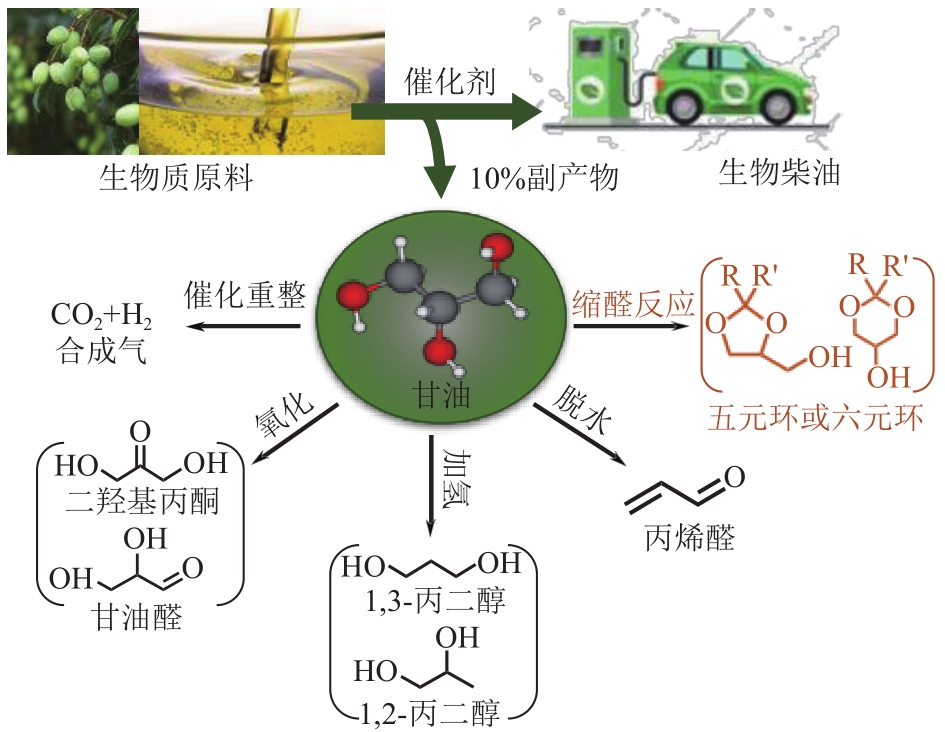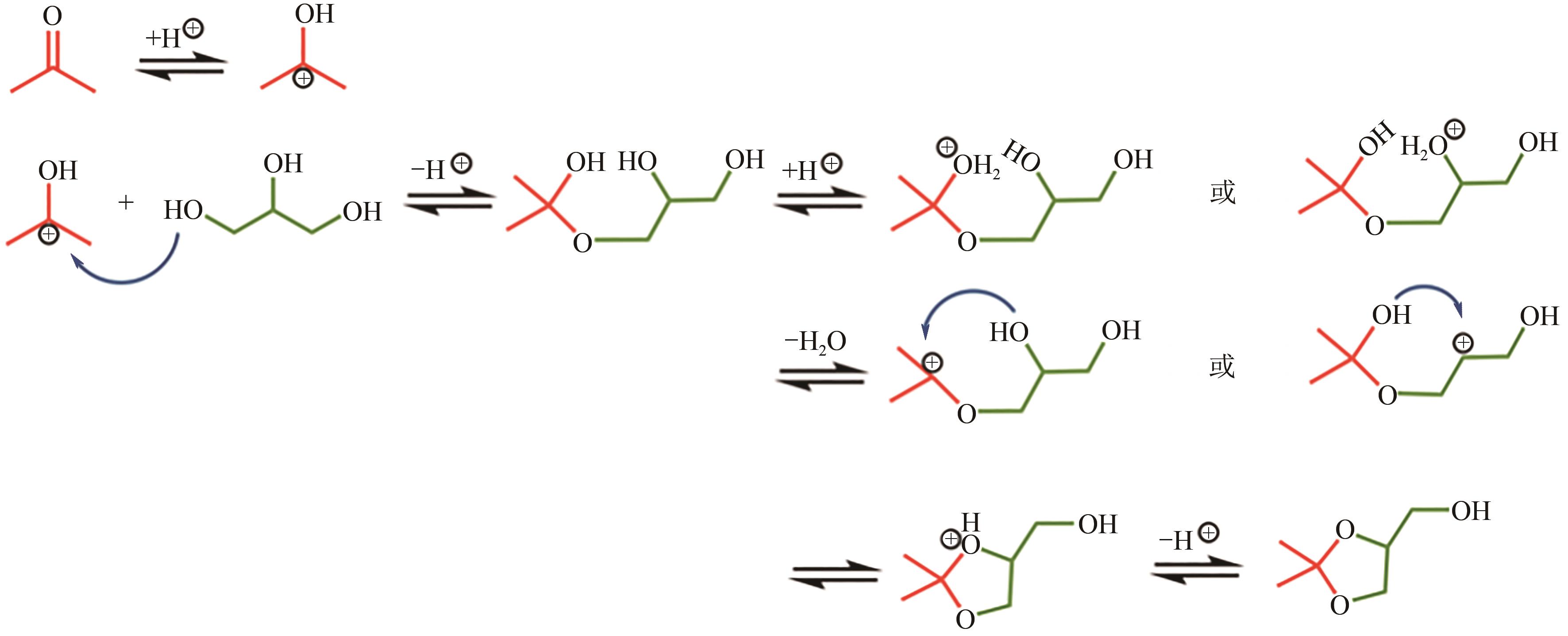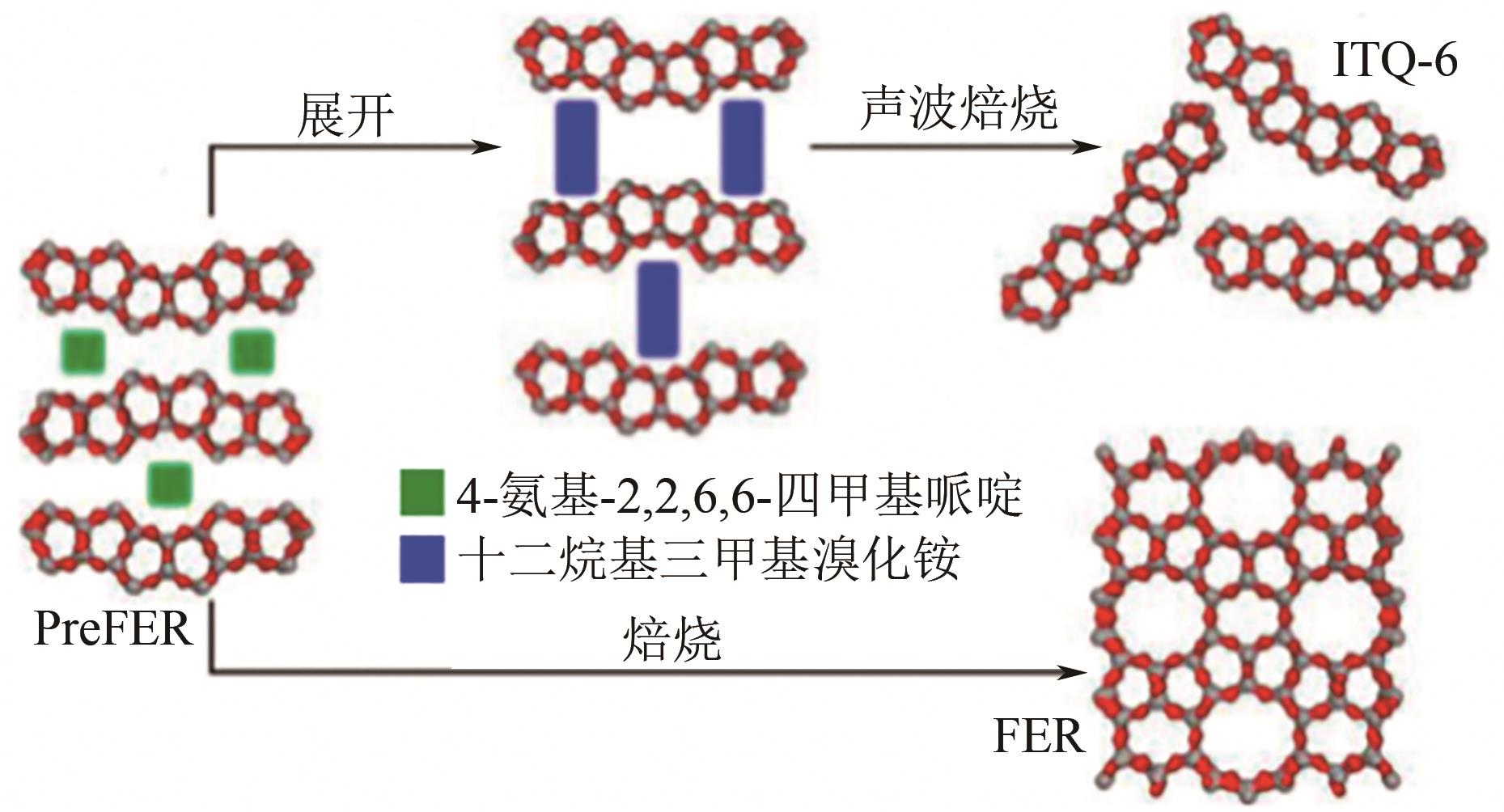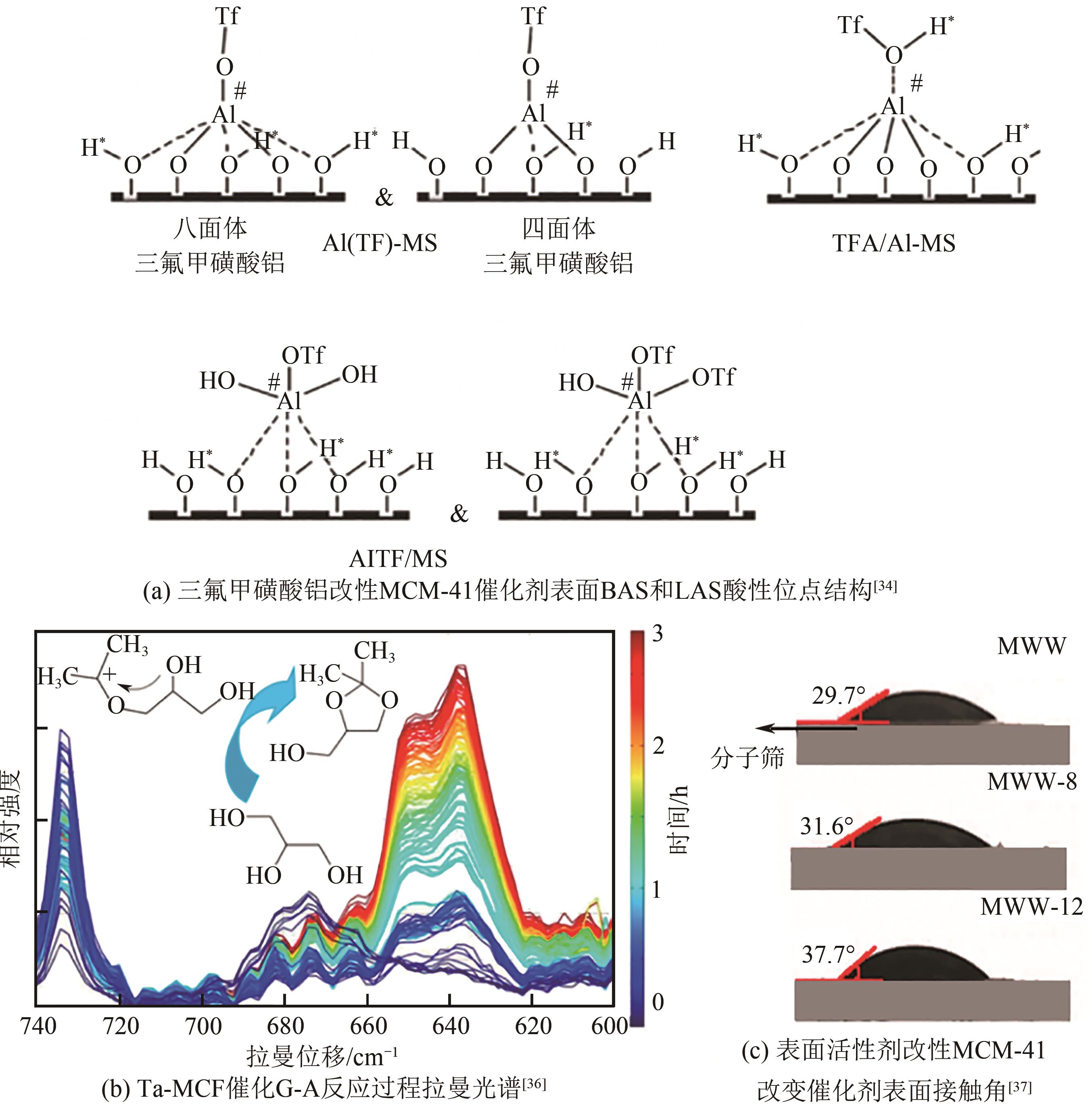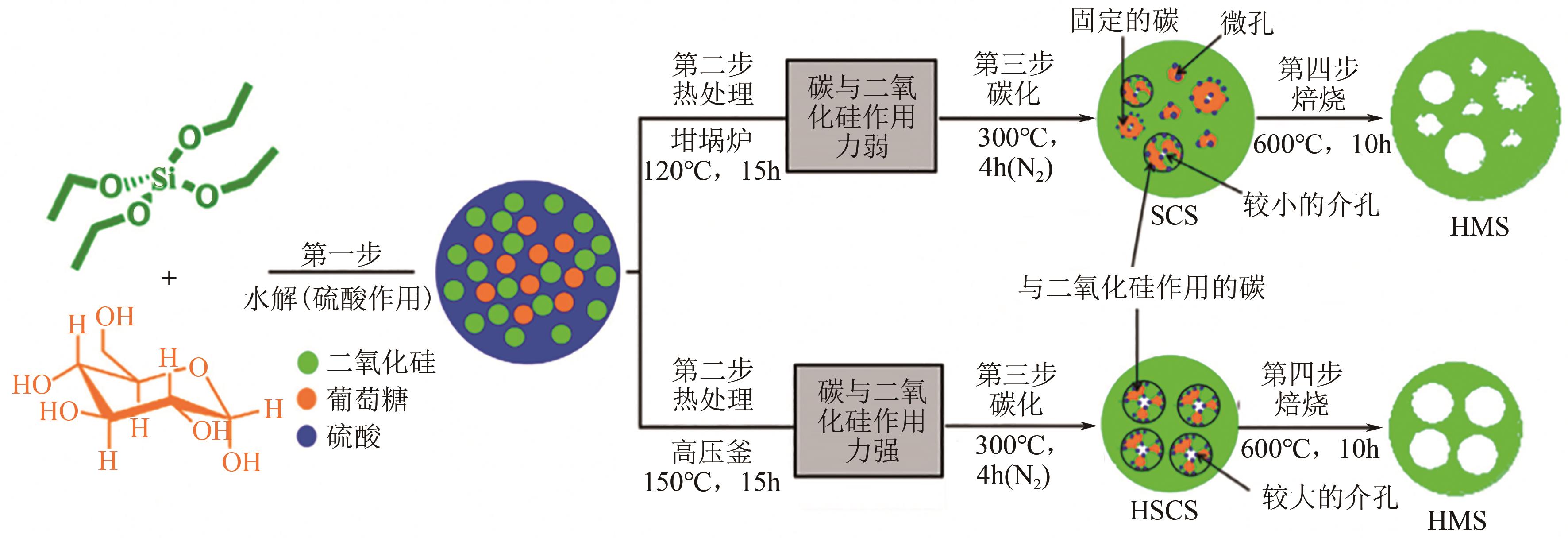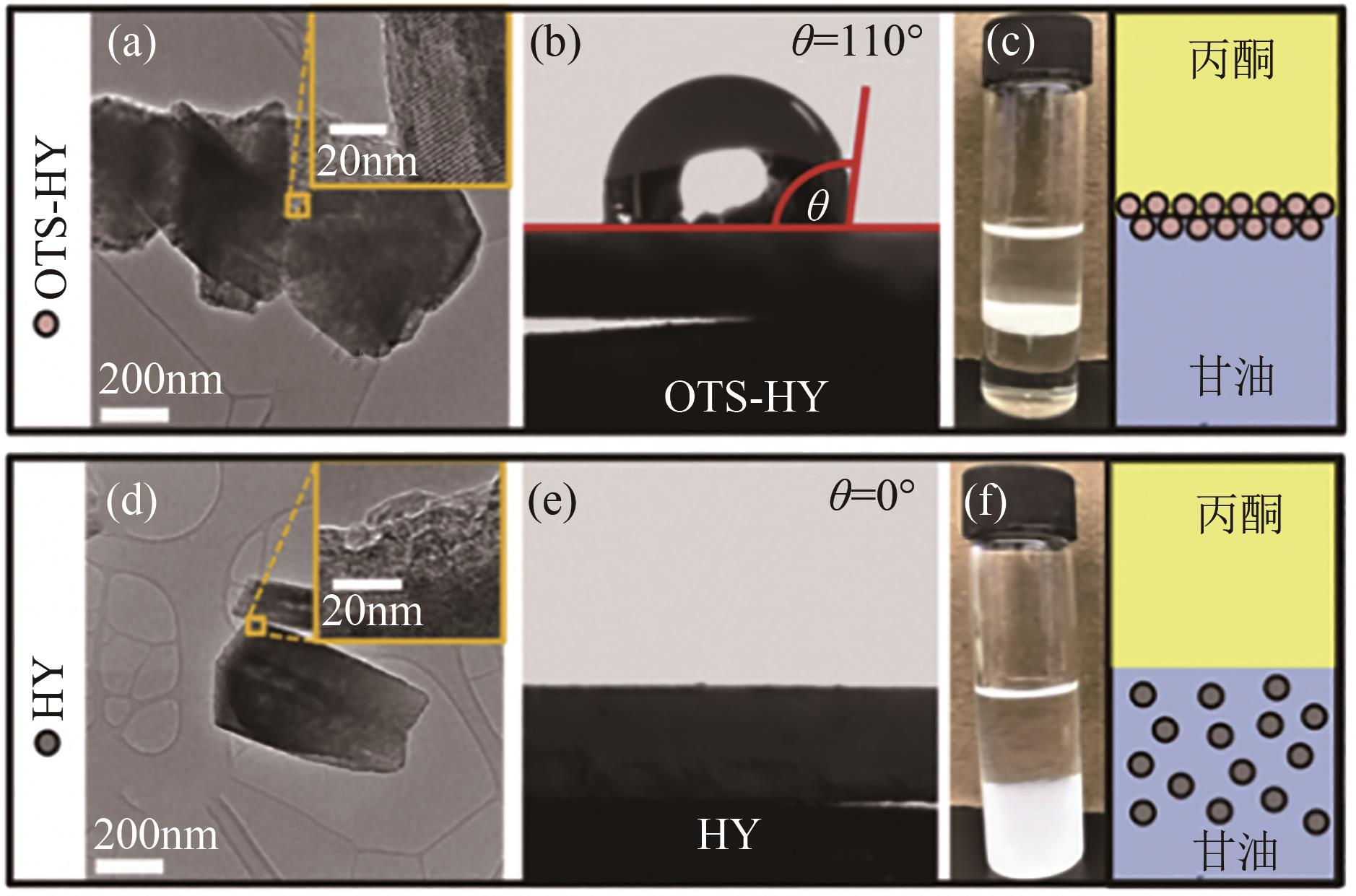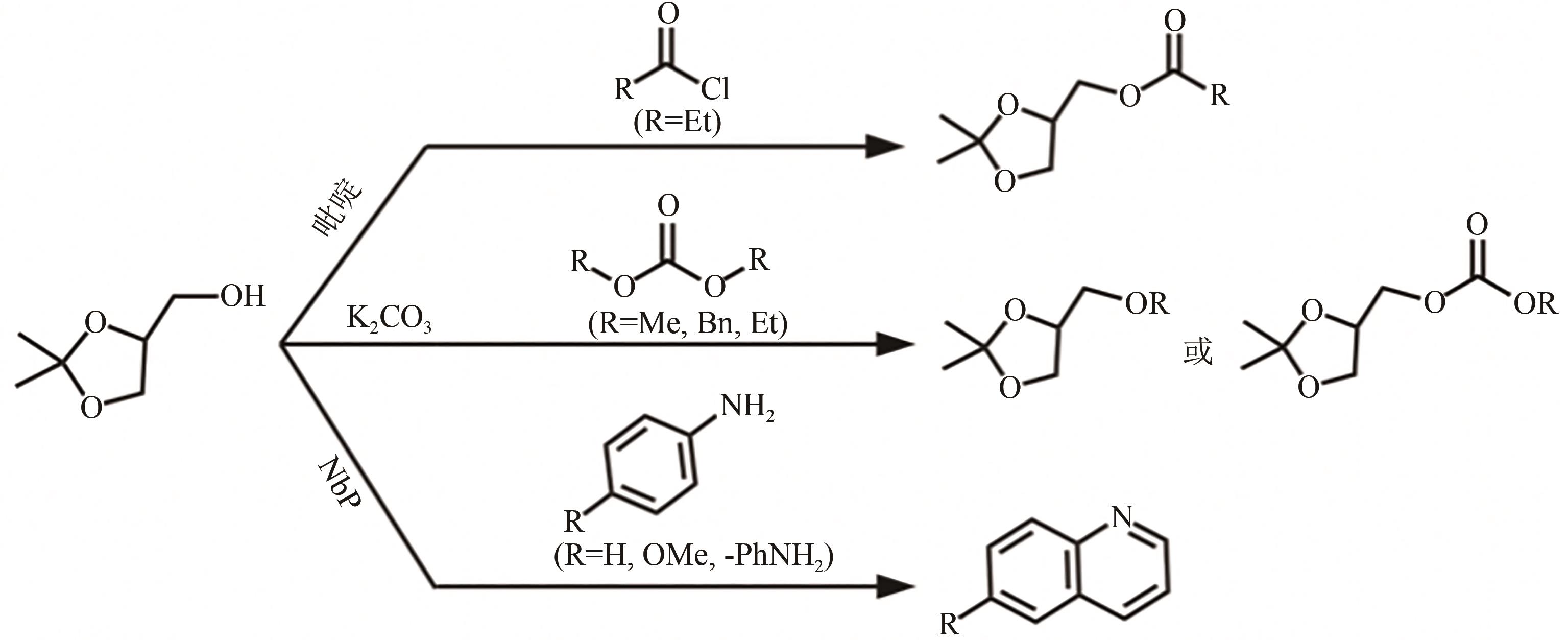Chemical Industry and Engineering Progress ›› 2023, Vol. 42 ›› Issue (2): 731-743.DOI: 10.16085/j.issn.1000-6613.2022-0759
• Industrial catalysis • Previous Articles Next Articles
Progress on solketal synthesis catalyzed by porous materials
JIN Xin1( ), LI Yushan1, XIE Qingqing1, WANG Mengyu1, XIA Xingfan2, YANG Chaohe1
), LI Yushan1, XIE Qingqing1, WANG Mengyu1, XIA Xingfan2, YANG Chaohe1
- 1.College of Chemistry and Chemical Engineering, China University of Petroleum, Qingdao 266580, Shandong, China
2.Petroleum Engineering Experimental Teaching Center, China University of Petroleum, Qingdao 266580, Shandong, China
-
Received:2022-04-26Revised:2022-06-10Online:2023-03-13Published:2023-02-25 -
Contact:JIN Xin
多孔材料催化丙酮缩甘油合成研究进展
金鑫1( ), 李玉姗1, 解青青1, 王梦雨1, 夏星帆2, 杨朝合1
), 李玉姗1, 解青青1, 王梦雨1, 夏星帆2, 杨朝合1
- 1.中国石油大学(华东)化学化工学院,山东 青岛 266580
2.中国石油大学(华东)石油工业训练中心,山东 青岛 266580
-
通讯作者:金鑫 -
作者简介:金鑫(1984—),男,教授,研究方向为生物基高端化学品的合成机理以及催化剂设计和相关工艺技术的开发。E-mail:jamesjinxin@upc.edu.cn。 -
基金资助:国家自然科学基金(22078365)
CLC Number:
Cite this article
JIN Xin, LI Yushan, XIE Qingqing, WANG Mengyu, XIA Xingfan, YANG Chaohe. Progress on solketal synthesis catalyzed by porous materials[J]. Chemical Industry and Engineering Progress, 2023, 42(2): 731-743.
金鑫, 李玉姗, 解青青, 王梦雨, 夏星帆, 杨朝合. 多孔材料催化丙酮缩甘油合成研究进展[J]. 化工进展, 2023, 42(2): 731-743.
share this article
Add to citation manager EndNote|Ris|BibTeX
URL: https://hgjz.cip.com.cn/EN/10.16085/j.issn.1000-6613.2022-0759
| 反应温度(Si/Al=90)/℃ | 初始反应速率/Con1/2·min-1 | 反应级数 | Si/Al比(25℃下) | 初始反应速率/Con1/2·min-1 | 反应级数 |
|---|---|---|---|---|---|
| 25 | 0.7415 | 1/2 | 30 | 0.6320 | 1/2 |
| 50 | 4.436 | -2.5 | 90 | 0.7415 | 1/2 |
| 60 | 1.3256 | -1.3 | 160 | 0.6500 | 1/2 |
| 反应温度(Si/Al=90)/℃ | 初始反应速率/Con1/2·min-1 | 反应级数 | Si/Al比(25℃下) | 初始反应速率/Con1/2·min-1 | 反应级数 |
|---|---|---|---|---|---|
| 25 | 0.7415 | 1/2 | 30 | 0.6320 | 1/2 |
| 50 | 4.436 | -2.5 | 90 | 0.7415 | 1/2 |
| 60 | 1.3256 | -1.3 | 160 | 0.6500 | 1/2 |
| 分子筛 | 初始反应速率/Con1/2·min-1 | 反应级数 |
|---|---|---|
| MCM-41 | 0.5766 | 0.1 |
| 磺化MCM-41 | 3.9 | -1 |
| 分子筛 | 初始反应速率/Con1/2·min-1 | 反应级数 |
|---|---|---|
| MCM-41 | 0.5766 | 0.1 |
| 磺化MCM-41 | 3.9 | -1 |
| PL速率方程 | ER速率方程 | LHHW速率方程 |
|---|---|---|
| PL1 | ER1 | LHHW1 |
| PL2 | ER2 | LHHW2 |
| PL3 | ER3 | LHHW3 |
| PL4 | ER4 | LHHW4 |
| PL速率方程 | ER速率方程 | LHHW速率方程 |
|---|---|---|
| PL1 | ER1 | LHHW1 |
| PL2 | ER2 | LHHW2 |
| PL3 | ER3 | LHHW3 |
| PL4 | ER4 | LHHW4 |
| 催化剂 | 温度/℃ | 溶剂 | 转化率/% | 选择性/% | 参考文献 |
|---|---|---|---|---|---|
| OTS-HY | 30 | — | 89 | 95 | [ |
| HUSY-W20 | 40 | — | 100 | 97.87 | [ |
| Sil-F | 70 | — | 65.8 | 63.9 | [ |
| 5%V-Si-ITQ-6 | 60 | — | 100 | 99 | [ |
| HUSY-Nb5 | 40 | — | 66 | 98 | [ |
| MIL-100-V | 70 | 5mL乙腈 | 85.4 | 97.7 | [ |
| MIL-100-Al | 70 | 5mL乙腈 | 44.2 | 94.3 | [ |
| MIL-100-Fe | 70 | 5mL乙腈 | 19.5 | 86.1 | [ |
| MIL-100-Cr | 70 | 5mL乙腈 | 4.2 | 77.5 | [ |
| Cu-Mor | RT | — | 95 | 98 | [ |
| Zn-Mor | RT | — | 90 | 81 | [ |
| Ni-Mor | RT | — | 93 | 88 | [ |
| Co-Mor | RT | — | 87 | 73 | [ |
| Fe-Mor | RT | — | 88 | 84 | [ |
| MFI-CA | 70 | — | 81 | 99 | [ |
| BEA-CA | 70 | — | 82 | 99 | [ |
| Mor-CA | 70 | — | 79 | 98 | [ |
| PDSA-BEA | 30 | — | 80 | 100 | [ |
| pTSA-BEA | 30 | — | 82 | 90 | [ |
| H-Beta | RT | — | 86 | 98.5 | [ |
| Sn-TUD-1 | 80 | 10mmol叔丁醇 | 44 | 99 | [ |
| Zr-TUD-1 | 80 | 10mmol叔丁醇 | 46 | 99 | [ |
| Hf-TUD-1 | 80 | 10mmol叔丁醇 | 52 | 99 | [ |
| Ga-MCM-41 | 25 | 15mL乙腈 | 75 | 95 | [ |
| XS-Ga-MCM-41 | 80 | 1.8g叔丁醇 | 28 | 99 | [ |
| TFAl-MCM-41 | 25 | 15mL乙腈 | 97 | 97 | [ |
| OS-MCM-22 | 40 | — | 81 | 95 | [ |
| Nb-SBA-16 | 50 | — | 86 | 96 | [ |
| ZrMo-KIT-6 | 50 | — | 85.8 | 97.8 | [ |
| Nb-MCF | 40 | — | 48 | 99 | [ |
| Ta-MCF | 40 | — | 74 | 99 | [ |
| Mo-MCF | 40 | — | 48 | 99 | [ |
| MP-MCF | 40 | — | 83 | 99 | [ |
| CS-MCF | 40 | — | 87 | 99 | [ |
| TFAl-MCM-41 | 30 | — | 92 | [ | |
| Sn-TUD-1 | 80 | 10mmol叔丁醇 | 44 | 99 | [ |
| Zr-TUD-1 | 80 | 10mmol叔丁醇 | 46 | 99 | [ |
| Hf-TUD-1 | 80 | 10mmol叔丁醇 | 52 | 99 | [ |
| MoPO-SBA-15 | RT | — | 100 | 98 | [ |
| Pr-SBA-15 | 70 | — | 79 | — | [ |
| Ar-SBA-15 | 70 | — | 82 | — | [ |
| 1M-MM | 50 | — | 57 | 97.4 | [ |
| HSCS | 70 | — | 80 | 98 | [ |
| SO3H-Cel | — | 80 | 95 | [ | |
| C-HSO3 | 50 | — | 80 | 99.5 | [ |
| 5%Ni–1%Zr/AC | 45 | — | 82 | 74 | [ |
| 催化剂 | 温度/℃ | 溶剂 | 转化率/% | 选择性/% | 参考文献 |
|---|---|---|---|---|---|
| OTS-HY | 30 | — | 89 | 95 | [ |
| HUSY-W20 | 40 | — | 100 | 97.87 | [ |
| Sil-F | 70 | — | 65.8 | 63.9 | [ |
| 5%V-Si-ITQ-6 | 60 | — | 100 | 99 | [ |
| HUSY-Nb5 | 40 | — | 66 | 98 | [ |
| MIL-100-V | 70 | 5mL乙腈 | 85.4 | 97.7 | [ |
| MIL-100-Al | 70 | 5mL乙腈 | 44.2 | 94.3 | [ |
| MIL-100-Fe | 70 | 5mL乙腈 | 19.5 | 86.1 | [ |
| MIL-100-Cr | 70 | 5mL乙腈 | 4.2 | 77.5 | [ |
| Cu-Mor | RT | — | 95 | 98 | [ |
| Zn-Mor | RT | — | 90 | 81 | [ |
| Ni-Mor | RT | — | 93 | 88 | [ |
| Co-Mor | RT | — | 87 | 73 | [ |
| Fe-Mor | RT | — | 88 | 84 | [ |
| MFI-CA | 70 | — | 81 | 99 | [ |
| BEA-CA | 70 | — | 82 | 99 | [ |
| Mor-CA | 70 | — | 79 | 98 | [ |
| PDSA-BEA | 30 | — | 80 | 100 | [ |
| pTSA-BEA | 30 | — | 82 | 90 | [ |
| H-Beta | RT | — | 86 | 98.5 | [ |
| Sn-TUD-1 | 80 | 10mmol叔丁醇 | 44 | 99 | [ |
| Zr-TUD-1 | 80 | 10mmol叔丁醇 | 46 | 99 | [ |
| Hf-TUD-1 | 80 | 10mmol叔丁醇 | 52 | 99 | [ |
| Ga-MCM-41 | 25 | 15mL乙腈 | 75 | 95 | [ |
| XS-Ga-MCM-41 | 80 | 1.8g叔丁醇 | 28 | 99 | [ |
| TFAl-MCM-41 | 25 | 15mL乙腈 | 97 | 97 | [ |
| OS-MCM-22 | 40 | — | 81 | 95 | [ |
| Nb-SBA-16 | 50 | — | 86 | 96 | [ |
| ZrMo-KIT-6 | 50 | — | 85.8 | 97.8 | [ |
| Nb-MCF | 40 | — | 48 | 99 | [ |
| Ta-MCF | 40 | — | 74 | 99 | [ |
| Mo-MCF | 40 | — | 48 | 99 | [ |
| MP-MCF | 40 | — | 83 | 99 | [ |
| CS-MCF | 40 | — | 87 | 99 | [ |
| TFAl-MCM-41 | 30 | — | 92 | [ | |
| Sn-TUD-1 | 80 | 10mmol叔丁醇 | 44 | 99 | [ |
| Zr-TUD-1 | 80 | 10mmol叔丁醇 | 46 | 99 | [ |
| Hf-TUD-1 | 80 | 10mmol叔丁醇 | 52 | 99 | [ |
| MoPO-SBA-15 | RT | — | 100 | 98 | [ |
| Pr-SBA-15 | 70 | — | 79 | — | [ |
| Ar-SBA-15 | 70 | — | 82 | — | [ |
| 1M-MM | 50 | — | 57 | 97.4 | [ |
| HSCS | 70 | — | 80 | 98 | [ |
| SO3H-Cel | — | 80 | 95 | [ | |
| C-HSO3 | 50 | — | 80 | 99.5 | [ |
| 5%Ni–1%Zr/AC | 45 | — | 82 | 74 | [ |
| 1 | 李亮荣, 李秋平, 艾盛, 等. 传统化石与新型生物质能源重整制氢研究现状[J]. 化学与生物工程, 2021, 38(11): 1-6. |
| LI Liangrong, LI Qiuping, AI Sheng, et al. Research status of hydrogen production from reforming of fossil energy and new biomass energy[J]. Chemistry & Bioengineering, 2021, 38(11): 1-6. | |
| 2 | 洪浩. 生物质能源产业的比较优势[J]. 能源, 2018(8): 71-73. |
| HONG Hao. Comparative advantages of biomass energy industry[J]. Energy, 2018(8): 71-73. | |
| 3 | ANDRE T. Renewables 2020 global status report[M]. Renewables 2020 Global Status Report, 2020. |
| 4 | RODRIGUES Raphael, MANDELLI Dalmo, GONÇALVES Norberto S, et al. Acetalization of acetone with glycerol catalyzed by niobium-aluminum mixed oxides synthesized by a sol-gel process[J]. Journal of Molecular Catalysis A: Chemical, 2016, 422: 122-130. |
| 5 | 姜莉莉, 朱宝伟, 李昌丽, 等. 微生物转化粗甘油制备高附加值产品的研究进展[J]. 生物质化学工程, 2021, 55(5): 60-66. |
| JIANG Lili, ZHU Baowei, LI Changli, et al. Research progress in microbial conversion crude glycerol to high value-added products[J]. Biomass Chemical Engineering, 2021, 55(5): 60-66. | |
| 6 | 胡琦艳, 杨德育. (R)-甘油醛缩丙酮的合成及Wittig反应选择性[J]. 化学研究, 2006, 17(2): 12-16. |
| HU Qiyan, YANG Deyu. Synthesis of (R)-glyceraldehyde acetonide and stereoselectivity of its Wittig reaction[J]. Chemical Research, 2006, 17(2): 12-16. | |
| 7 | 赵军, 王亚东. (S)-普萘洛尔的立体选择性合成[J]. 浙江工业大学学报, 1997, 25(3): 252-255. |
| ZHAO Jun, WANG Yadong. Stereoselective synthesis of β-blocker receptor (S)-propranolol[J]. Journal of Zhejiang University of Technology, 1997, 25(3): 252-255. | |
| 8 | EIBL Hansjörg. An improved method for the preparation of 1,2-isopropylidene-SN-glycerol[J]. Chemistry and Physics of Lipids, 1981, 28(1): 1-5. |
| 9 | 尹显洪. 相转移催化D-甘露醇合成镇咳药左旋羟苯哌嗪[J]. 化学试剂, 2001, 23(6): 349-350. |
| YIN Xianhong. Phase transfer catalyzed synthesis of (-)-dropropizine with D-mannitol as starting material[J]. Chemical Reagents, 2001, 23(6): 349-350. | |
| 10 | 赵军, 王亚东, 杨世琰. 催化氧化法合成缩丙酮-(R)-和(S)-甘油酸[J]. 合成化学, 1996, 4(1): 88-90. |
| ZHAO Jun, WANG Yadong, YANG Shiyan. Synthesis of 2,3-O-isopropylidene (R) glyceric acid and its (S) isomer by oxidation of RuCl3-NaClO[J]. Chinese Journal of Synthetic Chemistry, 1996, 4(1): 88-90. | |
| 11 | JANISZEWSKA E, KOWALSKA-KUŚ J, GÓRA-MAREK K, et al. Modification of silicalite-1 with ammonium compounds aimed at preparation of acidic catalyst for acetalization of glycerol with acetone[J]. Applied Catalysis A: General, 2019, 581: 1-10. |
| 12 | LOPES N F, CAIADO M, CANHÃO P, et al. Synthesis of bio-fuel additives from glycerol over poly(vinyl alcohol) with sulfonic acid groups[J]. Energy Sources, Part A: Recovery, Utilization, and Environmental Effects, 2015, 37(17): 1928-1936. |
| 13 | FERREIRA P, FONSECA I M, RAMOS A M, et al. Valorisation of glycerol by condensation with acetone over silica-included heteropolyacids[J]. Applied Catalysis B: Environmental, 2010, 98(1/2): 94-99. |
| 14 | MENEZES Fernanda D L, GUIMARAES Matheus D O, SILVA Márcio J DA. Highly selective SnCl2-catalyzed solketal synthesis at room temperature[J]. Industrial & Engineering Chemistry Research, 2013, 52(47): 16709-16713. |
| 15 | MANJUNATHAN Pandian, MARADUR Sanjeev P, HALGERI A B, et al. Room temperature synthesis of solketal from acetalization of glycerol with acetone: Effect of crystallite size and the role of acidity of beta zeolite[J]. Journal of Molecular Catalysis A: Chemical, 2015, 396: 47-54. |
| 16 | TIMOFEEVA M N, PANCHENKO V N, KHAN N A, et al. Isostructural metal-carboxylates MIL-100(M) and MIL-53(M) (M: V, Al, Fe and Cr) as catalysts for condensation of glycerol with acetone[J]. Applied Catalysis a-General, 2017, 529: 167-174. |
| 17 | ALSAWALHA Murad. Catalytic activity and kinetic modeling of various modules HZMS-5 and treated MCM-41 catalysts, for the liquid-phase ketalization of glycerol with acetone[J]. Frontiers in Chemistry, 2019, 7: 799. |
| 18 | LI Zhenbin, MIAO Zhichao, WANG Xuan, et al. One-pot synthesis of ZrMo-KIT-6 solid acid catalyst for solvent-free conversion of glycerol to solketal[J]. Fuel, 2018, 233: 377-387. |
| 19 | Amin TALEBIAN-KIAKALAIEH, TARIGHI Sara. Hierarchical faujasite zeolite-supported heteropoly acid catalyst for acetalization of crude-glycerol to fuel additives[J]. Journal of Industrial and Engineering Chemistry, 2019, 79: 452-464. |
| 20 | DE CARVALHO Davi C, OLIVEIRA Alcemira C, FERREIRA Odair P, et al. Titanate nanotubes as acid catalysts for acetalization of glycerol with acetone: Influence of the synthesis time and the role of structure on the catalytic performance[J]. Chemical Engineering Journal, 2017, 313: 1454-1467. |
| 21 | VIEIRA Luiz H, POSSATO Luiz G, CHAVES Thiago F, et al. Studies on dispersion and reactivity of vanadium oxides deposited on lamellar ferrierite zeolites for condensation of glycerol into bulky products[J]. Molecular Catalysis, 2018, 458: 161-170. |
| 22 | LI Li, KORáNYI Tamás I, SELS Bert F, et al. Highly-efficient conversion of glycerol to solketal over heterogeneous Lewis acid catalysts[J]. Green Chemistry, 2012, 14(6): 1611-1619. |
| 23 | PRIYA Samudrala Shanthi, SELVAKANNAN P R, CHARY Komandur V R, et al. Solvent-free microwave-assisted synthesis of solketal from glycerol using transition metal ions promoted mordenite solid acid catalysts[J]. Molecular Catalysis, 2017, 434: 184-193. |
| 24 | SILVA Márcio José DA, DE ÁVILA RODRIGUES Fabio, JÚLIO Armanda Aparecida. SnF2-catalyzed glycerol ketalization: A friendly environmentally process to synthesize solketal at room temperature over on solid and reusable Lewis acid[J]. Chemical Engineering Journal, 2017, 307: 828-835. |
| 25 | ESPOSITO Roberto, RAUCCI Umberto, CUCCIOLITO Maria E, et al. Iron(Ⅲ) complexes for highly efficient and sustainable ketalization of glycerol: A combined experimental and theoretical study[J]. ACS Omega, 2019, 4(1): 688-698. |
| 26 | VISWANADHAM Nagabhatla, DEBNATH Suman, SREENIVASULU Peta, et al. Nano porous hydroxyapatite as a bi-functional catalyst for bio-fuel production[J]. RSC Advances, 2015, 5(83): 67380-67383. |
| 27 | NANDA Malaya R, YUAN Zhongshun, QIN Wensheng, et al. Thermodynamic and kinetic studies of a catalytic process to convert glycerol into solketal as an oxygenated fuel additive[J]. Fuel, 2014, 117: 470-477. |
| 28 | ESTEBAN Jesús, LADERO Miguel, Félix GARCÍA-OCHOA. Kinetic modelling of the solventless synthesis of solketal with a sulphonic ion exchange resin[J]. Chemical Engineering Journal, 2015, 269: 194-202. |
| 29 | JOLANTA Kowalska-Kus, AGNIESZKA Held, KRYSTYNA Nowinska. Enhancement of the catalytic activity of H-ZSM-5 zeolites for glycerol acetalization by mechanical grinding[J]. Reaction Kinetics, Mechanisms and Catalysis, 2016, 117(1): 341-352. |
| 30 | RAHAMAN Mohammad Shahinur, PHUNG Thanh Khoa, HOSSAIN Md Anwar, et al. Hydrophobic functionalization of HY zeolites for efficient conversion of glycerol to solketal[J]. Applied Catalysis A: General, 2020, 592: 117369. |
| 31 | FERREIRA C, ARAUJO A, CALVINO-CASILDA V, et al. Y zeolite-supported niobium pentoxide catalysts for the glycerol acetalization reaction[J]. Microporous and Mesoporous Materials, 2018, 271: 243-251. |
| 32 | Agnieszka FELICZAK-GUZIK, NOWAK Izabela. Application of glycerol to synthesis of solvo-surfactants by using mesoporous materials containing niobium[J]. Microporous and Mesoporous Materials, 2019, 277: 301-308. |
| 33 | COLLARD Xavier, LI Li, LUEANGCHAICHAWENG Warunee, et al. Ga-MCM-41 nanoparticles: Synthesis and application of versatile heterogeneous catalysts[J]. Catalysis Today, 2014, 235: 184-192. |
| 34 | TAYADE Kamlesh N, MISHRA Manish, Munusamy K, et al. Synthesis of aluminium triflate-grafted MCM-41 as a water-tolerant acid catalyst for the ketalization of glycerol with acetone[J]. Catalysis Science & Technology, 2015, 5(4): 2427-2440. |
| 35 | KHAYOON M S, HAMEED B H. Solventless acetalization of glycerol with acetone to fuel oxygenates over Ni-Zr supported on mesoporous activated carbon catalyst[J]. Applied Catalysis A: General, 2013, 464/465: 191-199. |
| 36 | CALVINO-CASILDA V, STAWICKA K, TREJDA M, et al. Real-time Raman monitoring and control of the catalytic acetalization of glycerol with acetone over modified mesoporous cellular foams[J]. The Journal of Physical Chemistry C, 2014, 118(20): 10780-10791. |
| 37 | RODRIGUES Mariana, OKOLIE Chukwuemeka, SIEVERS Carsten, et al. Organosilane-assisted synthesis of hierarchical MCM-22 zeolites for condensation of glycerol into bulky products[J]. Crystal Growth & Design, 2019, 19(1): 231-241. |
| 38 | LI Li, CANI Damiano, PESCARMONA Paolo P. Metal-containing TUD-1 mesoporous silicates as versatile solid acid catalysts for the conversion of bio-based compounds into valuable chemicals[J]. Inorganica Chimica Acta, 2015, 431: 289-296. |
| 39 | Katarzyna Stawicka, DÍAZ ÁLVAREZ ALBA E, Calvino Casilda Vanesa, et al. The role of Brønsted and Lewis acid sites in acetalization of glycerol over modified mesoporous cellular foams[J]. The Journal of Physical Chemistry C, 2016, 120(30): 16699-16711. |
| 40 | KOWALSKA-KUS J, HELD A, FRANKOWSKI M, et al. Solketal formation from glycerol and acetone over hierarchical zeolites of different structure as catalysts[J]. Journal of Molecular Catalysis A: Chemical, 2017, 426: 205-212. |
| 41 | VENKATESHA N J, BHAT Y S, PRAKASH B S JAI. Dealuminated BEA zeolite for selective synthesis of five-membered cyclic acetal from glycerol under ambient conditions[J]. RSC Advances, 2016, 6(23): 18824-18833. |
| 42 | VICENTE Gemma, MELERO Juan A, MORALES Gabriel, et al. Acetalisation of bio-glycerol with acetone to produce solketal over sulfonic mesostructured silicas[J]. Green Chemistry, 2010, 12(5): 899-907. |
| 43 | NANDAN Devaki, SREENIVASULU Peta, SIVAKUMAR KONATHALA L N, et al. Acid functionalized carbon-silica composite and its application for solketal production[J]. Microporous and Mesoporous Materials, 2013, 179: 182-190. |
| 44 | FERNÁNDEZ P, FRAILE J M, GARCÍA-BORDEJÉ E, et al. Sulfonated hydrothermal carbons from cellulose and glucose as catalysts for glycerol ketalization[J]. Catalysts, 2019, 9(10): 804. |
| 45 | KONWAR Lakhya Jyoti, SAMIKANNU Ajaikumar, Päivi MÄKI-ARVELA, et al. Lignosulfonate-based macro/mesoporous solid protonic acids for acetalization of glycerol to bio-additives[J]. Applied Catalysis B: Environmental, 2018, 220: 314-323. |
| 46 | Maraísa GONÇALVES, RODRIGUES Raphael, GALHARDO Thalita S, et al. Highly selective acetalization of glycerol with acetone to solketal over acidic carbon-based catalysts from biodiesel waste[J]. Fuel, 2016, 181: 46-54. |
| 47 | TIMOFEEVA Maria N, PANCHENKO Valentina N, KRUPSKAYA Victoria V, et al. Effect of nitric acid modification of montmorillonite clay on synthesis of solketal from glycerol and acetone[J]. Catalysis Communications, 2017, 90: 65-69. |
| 48 | RODRIGUES Raphael, Maraisa GONçALVES, MANDELLI Dalmo, et al. Solvent-free conversion of glycerol to solketal catalysed by activated carbons functionalised with acid groups[J]. Catalysis Science & Technology, 2014, 4(8): 2293-2301. |
| 49 | GADAMSETTI Sailaja, Pethan RAJAN N, RAO G Srinivasa, et al. Acetalization of glycerol with acetone to bio fuel additives over supported molybdenum phosphate catalysts[J]. Journal of Molecular Catalysis A: Chemical, 2015, 410: 49-57. |
| 50 | KITTICHAI Chaiseeda, LADAWAN Chantharadet, WARINTHORN Chavasiri. Utilization of hexabromoacetone for protection of alcohols and aldehydes and deprotection of acetals, ketals, and oximes under UV irradiation[J]. Research on Chemical Intermediates, 2018, 44(2): 1305-1323. |
| 51 | SELVA Maurizio, BENEDET Vanni, FABRIS Massimo. Selective catalytic etherification of glycerol formal and solketal with dialkyl carbonates and K2CO3 [J]. Green Chemistry, 2012, 14(1): 188-200. |
| 52 | JIN Jing, GUIDI Sandro, ABADA Zahra, et al. Continuous niobium phosphate catalysed Skraup reaction for quinoline synthesis from solketal[J]. Green Chemistry, 2017, 19(10): 2439-2447. |
| [1] | ZHANG Mingyan, LIU Yan, ZHANG Xueting, LIU Yake, LI Congju, ZHANG Xiuling. Research progress of non-noble metal bifunctional catalysts in zinc-air batteries [J]. Chemical Industry and Engineering Progress, 2023, 42(S1): 276-286. |
| [2] | SHI Yongxing, LIN Gang, SUN Xiaohang, JIANG Weigeng, QIAO Dawei, YAN Binhang. Research progress on active sites in Cu-based catalysts for CO2 hydrogenation to methanol [J]. Chemical Industry and Engineering Progress, 2023, 42(S1): 287-298. |
| [3] | XIE Luyao, CHEN Songzhe, WANG Laijun, ZHANG Ping. Platinum-based catalysts for SO2 depolarized electrolysis [J]. Chemical Industry and Engineering Progress, 2023, 42(S1): 299-309. |
| [4] | YANG Xiazhen, PENG Yifan, LIU Huazhang, HUO Chao. Regulation of active phase of fused iron catalyst and its catalytic performance of Fischer-Tropsch synthesis [J]. Chemical Industry and Engineering Progress, 2023, 42(S1): 310-318. |
| [5] | ZHENG Qian, GUAN Xiushuai, JIN Shanbiao, ZHANG Changming, ZHANG Xiaochao. Photothermal catalysis synthesis of DMC from CO2 and methanol over Ce0.25Zr0.75O2 solid solution [J]. Chemical Industry and Engineering Progress, 2023, 42(S1): 319-327. |
| [6] | WANG Zhengkun, LI Sifang. Green synthesis of gemini surfactant decyne diol [J]. Chemical Industry and Engineering Progress, 2023, 42(S1): 400-410. |
| [7] | WANG Lele, YANG Wanrong, YAO Yan, LIU Tao, HE Chuan, LIU Xiao, SU Sheng, KONG Fanhai, ZHU Canghai, XIANG Jun. Influence of spent SCR catalyst blending on the characteristics and deNO x performance for new SCR catalyst [J]. Chemical Industry and Engineering Progress, 2023, 42(S1): 489-497. |
| [8] | DENG Liping, SHI Haoyu, LIU Xiaolong, CHEN Yaoji, YAN Jingying. Non-noble metal modified vanadium titanium-based catalyst for NH3-SCR denitrification simultaneous control VOCs [J]. Chemical Industry and Engineering Progress, 2023, 42(S1): 542-548. |
| [9] | GENG Yuanze, ZHOU Junhu, ZHANG Tianyou, ZHU Xiaoyu, YANG Weijuan. Homogeneous/heterogeneous coupled combustion of heptane in a partially packed bed burner [J]. Chemical Industry and Engineering Progress, 2023, 42(9): 4514-4521. |
| [10] | CHENG Tao, CUI Ruili, SONG Junnan, ZHANG Tianqi, ZHANG Yunhe, LIANG Shijie, PU Shi. Analysis of impurity deposition and pressure drop increase mechanisms in residue hydrotreating unit [J]. Chemical Industry and Engineering Progress, 2023, 42(9): 4616-4627. |
| [11] | WANG Peng, SHI Huibing, ZHAO Deming, FENG Baolin, CHEN Qian, YANG Da. Recent advances on transition metal catalyzed carbonylation of chlorinated compounds [J]. Chemical Industry and Engineering Progress, 2023, 42(9): 4649-4666. |
| [12] | GAO Yanjing. Analysis of international research trend of single-atom catalysis technology [J]. Chemical Industry and Engineering Progress, 2023, 42(9): 4667-4676. |
| [13] | ZHANG Qi, ZHAO Hong, RONG Junfeng. Research progress of anti-toxicity electrocatalysts for oxygen reduction reaction in PEMFC [J]. Chemical Industry and Engineering Progress, 2023, 42(9): 4677-4691. |
| [14] | GE Quanqian, XU Mai, LIANG Xian, WANG Fengwu. Research progress on the application of MOFs in photoelectrocatalysis [J]. Chemical Industry and Engineering Progress, 2023, 42(9): 4692-4705. |
| [15] | WANG Weitao, BAO Tingyu, JIANG Xulu, HE Zhenhong, WANG Kuan, YANG Yang, LIU Zhaotie. Oxidation of benzene to phenol over aldehyde-ketone resin based metal-free catalyst [J]. Chemical Industry and Engineering Progress, 2023, 42(9): 4706-4715. |
| Viewed | ||||||
|
Full text |
|
|||||
|
Abstract |
|
|||||
